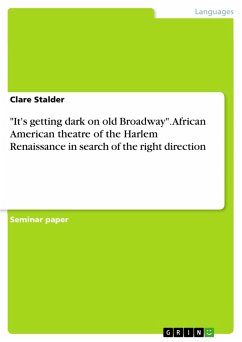Seminar paper from the year 2011 in the subject Didactics - English - History of Literature, Eras, grade: 2,0, Free University of Berlin, language: English, abstract: [...] When Gilda Gray performed "It's Getting Dark on Old Broadway" in the opening show of the song-and-dance revue Ziegfeld Follies on 5 June 1922 she eternalized Broadway's latest trend (Woll 76). Black entertainment proliferated in the Theatre District along Broadway in the 1920s and it seemed that black shows had made it into the limelight of success. There was, however, a different 'dark' side to the developments of the black performance scene. To many leading intellectuals of the Harlem Renaissance, the new darkness on Broadway looked rather bleak. Important figures like W. E. B. Du Bois who campaigned for a new racial identity through cultural creation (cf. Du Bois "Criteria of Negro Art") feared that the new phenomenon of black productions reaching out for mainstream success would betray their cause. In his speech at the NAACP's annual conference, he famously claimed that "all Art is propaganda and ever must be" (Du Bois par. 29). Catering to the white public's demands (pars. 33, 35), as the successful Black Broadway musicals did, would mean failing the cause, according to Du Bois. While some scholars argue that theatre and performance in the New Negro era played "a pivotal role in the evolution of Black Nationalism" (Krasner 1), those are opposed by a number of authors who look upon the Harlem Renaissance as a failure (cf. Baker xiii, Neal 39, Krasner 95f.). In the following paper, I will look into the question of whether the performers and artists of the Harlem Renaissance really failed to contribute to a change of white America's attitude toward the African American race (Krasner 14). One point at issue will be whether the increasing success and commercialisation of Black theatre counteracted the objectives of racial renewal or if on the contrary, they were a means to an end. [...]
Dieser Download kann aus rechtlichen Gründen nur mit Rechnungsadresse in A, B, BG, CY, CZ, D, DK, EW, E, FIN, F, GR, HR, H, IRL, I, LT, L, LR, M, NL, PL, P, R, S, SLO, SK ausgeliefert werden.









